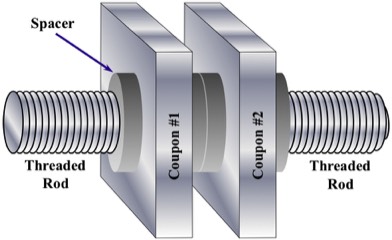Currently viewing
Menu
One Possible Procedure for a Mass Loss Exposure Test
One Possible Procedure
for a
Mass Loss Exposure Test
Before the Test
➤Mass Loss Coupons are 'ground and then polished' to the desired surface condition.
➤The exposed surface area of each Coupon is calculated from measurements taken using an instrument such as a caliper.
➤Coupons are degreased, cleaned, and dried.
➤Clean Coupons should be handled with rubber gloves.
➤Clean Coupons must not come in contact with anything that may contaminate them.
➤If the Test will not be run immediately, Clean Coupons should be stored in a desiccator.
➤For comparison, duplicates or triplicates of each alloy may be exposed.
➤To assess localized corrosion behavior, stressed or creviced Coupons may also be tested.
➤Coupons are accurately weighed to find the initial mass.
➤In the Figure below: Coupons are mounted on a threaded rod which has been degreased, cleaned, and dried.
➤In the Figure below: Spacers isolate the Coupons from the Rod, preventing galvanic effects.
➤Mass Loss Coupons are 'ground and then polished' to the desired surface condition.
➤The exposed surface area of each Coupon is calculated from measurements taken using an instrument such as a caliper.
➤Coupons are degreased, cleaned, and dried.
➤Clean Coupons should be handled with rubber gloves.
➤Clean Coupons must not come in contact with anything that may contaminate them.
➤If the Test will not be run immediately, Clean Coupons should be stored in a desiccator.
➤For comparison, duplicates or triplicates of each alloy may be exposed.
➤To assess localized corrosion behavior, stressed or creviced Coupons may also be tested.
➤Coupons are accurately weighed to find the initial mass.
➤In the Figure below: Coupons are mounted on a threaded rod which has been degreased, cleaned, and dried.
➤In the Figure below: Spacers isolate the Coupons from the Rod, preventing galvanic effects.
During the Test
➤Coupons are exposed to the environment of interest.
➤It is possible to periodically remove samples in order to document the change in the Corrosion Rate or the Penetration Rate as a function of time.
➤Coupons are exposed to the environment of interest.
➤It is possible to periodically remove samples in order to document the change in the Corrosion Rate or the Penetration Rate as a function of time.

After the Test
➤Coupons are removed from the environment and re-weighed to find the final mass.
➤The procedure to remove encrusted corrosion product can be found in the literature.
➤Coupons are generally examined with an optical microscope.
➤Coupons may also be examined with an SEM (scanning electron microscope).
➤Coupons may also be examined with other instruments to determine the makeup of the corrosion product.
➤It is always good practice to examine a sample in a number of ways - for example: Mass Loss - Microscopy - Chemical Analysis - etc.
➤Coupons are removed from the environment and re-weighed to find the final mass.
➤The procedure to remove encrusted corrosion product can be found in the literature.
➤Coupons are generally examined with an optical microscope.
➤Coupons may also be examined with an SEM (scanning electron microscope).
➤Coupons may also be examined with other instruments to determine the makeup of the corrosion product.
➤It is always good practice to examine a sample in a number of ways - for example: Mass Loss - Microscopy - Chemical Analysis - etc.
Finding the Corrosion Rate or Penetration Rate
The Δm (change in mass or mass loss) is determined by finding the difference between the initial mass and the final mass.
Once the change in mass is known, the Corrosion Rate or Penetration Rate can be found by using a simple equation.
The Δm (change in mass or mass loss) is determined by finding the difference between the initial mass and the final mass.
Once the change in mass is known, the Corrosion Rate or Penetration Rate can be found by using a simple equation.
rate = Δm/t A ρ
The Corrosion Rate is equivalent to Δm (mass loss) divided by t (time) and A (area).
If you also divide by ρ (density), you can find the Penetration Rate (average depth of metal lost). The Penetration Rate is generally specified in mmpy (millimeters per year) or in mpy (mils per year). A mil is 1/1000 inch.
If you also divide by ρ (density), you can find the Penetration Rate (average depth of metal lost). The Penetration Rate is generally specified in mmpy (millimeters per year) or in mpy (mils per year). A mil is 1/1000 inch.
Currently viewing
Page last updated: 12/16/23
